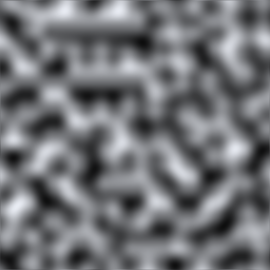Parámetros
| x | X-coordinate of sample point. |
| y | Y-coordinate of sample point. |
Valor de retorno
float Valor entre 0.0 y 1.0.
Descripción
Genera ruido Perlin 2D.
El sonido Perlin es un patrón pseudo-aleatorio de valores flotantes generados través de un plano 2D ( aunque
la técnica generaliza a tres o más dimensiones , esto no se aplica en Unity) .
El sonido no contiene un valor completamente al azar en cada punto, sino mas bien consiste
de "olas" cuyos valores aumentan y disminuyen gradualmente en todo el patrón. El sonido puede
be used as the basis for texture effects but also for animation, generating terrain heightmaps
and many other things.
Perlin noise sampled in the range 0..10 (the greyscale values represent values from 0..1)
Any point in the plane can be sampled by passing the appropriate X and Y coordinates. The
same coordinates will always return the same sample value but the plane is essentially infinite
so it is easy to avoid repetition by choosing a random area to sample from.
// Create a texture and fill it with Perlin noise. // Try varying the xOrg, yOrg and scale values in the inspector // while in Play mode to see the effect they have on the noise.
// Width and height of the texture in pixels. var pixWidth: int; var pixHeight: int;
// The origin of the sampled area in the plane. var xOrg: float; var yOrg: float;
// The number of cycles of the basic noise pattern that are repeated // over the width and height of the texture. var scale = 1.0;
private var noiseTex: Texture2D; private var pix: Color[]; private var rend: Renderer;
function Start () { rend = GetComponent.<Renderer>(); // Set up the texture and a Color array to hold pixels during processing. noiseTex = new Texture2D(pixWidth, pixHeight); pix = new Color[noiseTex.width * noiseTex.height]; rend.material.mainTexture = noiseTex; }
function CalcNoise() { // For each pixel in the texture... for (var y = 0.0; y < noiseTex.height; y++) { for (var x = 0.0; x < noiseTex.width; x++) { // Get a sample from the corresponding position in the noise plane // and create a greyscale pixel from it. var xCoord = xOrg + x / noiseTex.width * scale; var yCoord = yOrg + y / noiseTex.height * scale; var sample = Mathf.PerlinNoise(xCoord, yCoord); pix[y * noiseTex.width + x] = new Color(sample, sample, sample); } } // Copy the pixel data to the texture and load it into the GPU. noiseTex.SetPixels(pix); noiseTex.Apply(); }
function Update () { CalcNoise(); }
using UnityEngine; using System.Collections;
public class ExampleClass : MonoBehaviour { public int pixWidth; public int pixHeight; public float xOrg; public float yOrg; public float scale = 1.0F; private Texture2D noiseTex; private Color[] pix; private Renderer rend; void Start() { rend = GetComponent<Renderer>(); noiseTex = new Texture2D(pixWidth, pixHeight); pix = new Color[noiseTex.width * noiseTex.height]; rend.material.mainTexture = noiseTex; } void CalcNoise() { float y = 0.0F; while (y < noiseTex.height) { float x = 0.0F; while (x < noiseTex.width) { float xCoord = xOrg + x / noiseTex.width * scale; float yCoord = yOrg + y / noiseTex.height * scale; float sample = Mathf.PerlinNoise(xCoord, yCoord); pix[y * noiseTex.width + x] = new Color(sample, sample, sample); x++; } y++; } noiseTex.SetPixels(pix); noiseTex.Apply(); } void Update() { CalcNoise(); } }
Although the noise plane is two-dimensional, it is easy to use just a single one-dimensional line through the pattern, say for animation effects.
// "Bobbing" animation from 1D Perlin noise. // Range over which height varies. var heightScale = 1.0; // Distance covered per second along X axis of Perlin plane. var xScale = 1.0; function Update () { var height = heightScale * Mathf.PerlinNoise(Time.time * xScale, 0.0); var pos = transform.position; pos.y = height; transform.position = pos; }
using UnityEngine; using System.Collections;
public class ExampleClass : MonoBehaviour { public float heightScale = 1.0F; public float xScale = 1.0F; void Update() { float height = heightScale * Mathf.PerlinNoise(Time.time * xScale, 0.0F); Vector3 pos = transform.position; pos.y = height; transform.position = pos; } }
Note: It is possible for the return value to slightly exceed 1.0f. You may need to clamp the return value if the 0.0 to 1.0 range is important to you.